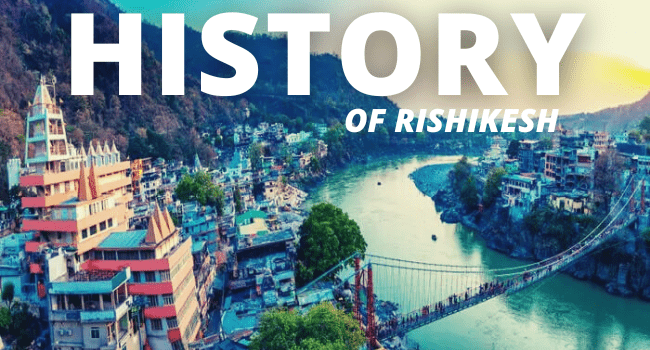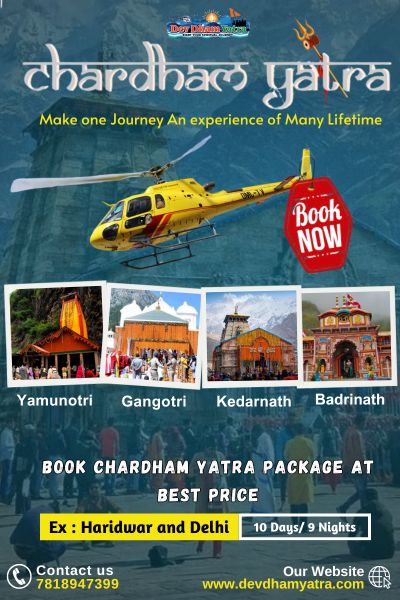यह पूजा स्थल देवताओं का निवास स्थान है। यह तीन ओर से हिमालय की शिवालिक श्रृंखला से घिरा हुआ है। ऋषिकेश आगंतुकों के लिए गहरा आध्यात्मिक और सांस्कृतिक महत्व रखता है। यह हिंदू चारधाम यात्रा का प्रारंभिक बिंदु है, जिसमें यमुनोत्री, गंगोत्री, केदारनाथ और बद्रीनाथ शामिल हैं, जिनकी यात्रा आध्यात्मिक मोक्ष की प्राप्ति के लिए की जाती है।
इस स्थान को ऋषिकेश के नाम से कैसे जाना गया?
‘हृषीकेश’ शब्द के बारे में माना जाता है कि यह दो शब्दों से मिलकर बना है: हृषीक, जिसका अर्थ है इंद्रियाँ, और ईश, जिसका अर्थ है स्वामी। यह भगवान विष्णु की ओर संकेत करता है, जो इंद्रियों के स्वामी हैं और जो इस रूप में (हृषीकेश) प्रकट हुए थे ताकि ऋषि रैभ्य को आशीर्वाद दे सकें।कई पौराणिक कथाओं के अनुसार, ऋषिकेश का ( History Of Rishikesh)इतिहास बताता है कि एक प्रसिद्ध संत रैभ्य ऋषि ने गंगा नदी के तट पर कठोर तपस्या की थी। उनकी तपस्या से प्रसन्न होकर भगवान विष्णु ने हृषीकेश के रूप में उन्हें दर्शन दिए।इसी कारण से यह स्थान भगवान विष्णु के हृषीकेश नाम से प्रसिद्ध हुआ, जिसे आगे चलकर ऋषिकेश के नाम से जाना जाने लगा।

ऋषिकेश को और किस नाम से जाना जाता है?
इस स्थान को अग्नितीर्थ के नाम से भी जाना जाता है, क्योंकि ऐसा माना जाता है कि अग्निदेव ने यहाँ भगवान शिव के क्रोध को शांत करने के लिए तपस्या की थी।
ऋषिकेश का उल्लेख पुराणों में भी मिलता है, जहाँ इसे वह स्थान बताया गया है जहाँ भगवान विष्णु ने शक्तिशाली असुर मधु का वध किया था।
ऋषिकेश को ‘केदारखण्ड’ (जो कि वर्तमान में गढ़वाल क्षेत्र है) का हिस्सा माना गया है।
स्कंद पुराण के ‘केदार खण्ड’ में भी इस स्थान पर इंद्रकुंड के अस्तित्व का उल्लेख मिलता है।
About The Town History of Rishikesh (ऋषिकेश नगर का इतिहास)
ऋषिकेश नगर महाकाव्य रामायण में भी महत्वपूर्ण भूमिका निभाता है, क्योंकि इसी पवित्र नगर में राम अपने भाइयों के साथ रावण को मारने के बाद प्रायश्चित करने आए थे। जबकि राम ने ऋषिकेश से थोड़ा आगे देवप्रयाग में प्रायश्चित किया, उनके दो छोटे भाई लक्ष्मण और शत्रुघ्न ने ऋषिकेश में गंगा नदी के किनारे प्रायश्चित किया।
जहाँ दोनों भाइयों ने ध्यान किया था, वहाँ उन स्थानों की पवित्रता को चिह्नित करने के लिए दो मंदिर हैं। वह स्थान जहाँ लक्ष्मण ने गंगा पार की थी, वहाँ कई शताब्दियों तक एक बांस की रस्सी का पुल था, जो 1889 तक वैसा ही रहा, इसके बाद एक लोहे की रस्सी का निलंबन पुल, जिसे लक्ष्मण झूला कहा गया, तीर्थयात्रियों की सुविधा के लिए बनाया गया। जब यह पुल 1924 में आई बाढ़ में बह गया, तो इसके स्थान पर कोलकाता के झुंझुनवाला परिवार ने एक नया पुल बनवाया।
लक्ष्मण झूला से थोड़ी दूरी पर, शिवानंद नगर के पास, 1986 में एक और समान निलंबन पुल बनाया गया, जिसे राम झूला नाम दिया गया। यह पुल तपोवन, टिहरी और जोंक, पौड़ी गढ़वाल के दो जिलों को जोड़ता है। 1986 में पास के शिवानंद नगर में भी एक समान निलंबन पुल राम झूला बनाया गया। राम झूला को शिवानंद झूला के नाम से भी जाना जाता

भगवान राम के छोटे भाई ने भी ऋषिकेश में गहरी तपस्या की थी। इसलिए भरत मंदिर का नाम उनके नाम पर रखा गया है, जो त्रिवेणी घाट के पास स्थित भगवान विष्णु का एक भव्य मंदिर है। ऐतिहासिक रिकॉर्ड्स में यह भी उल्लेख है कि कुछ तीर्थयात्री यात्रा के दौरान उच्च पर्वतों की ओर जाने से पहले ऋषिकेश में विश्राम करने के लिए रुकते थे, जबकि एक बड़ी संख्या ऋषिकेश को अपनी मूल गंतव्य के रूप में यात्रा करती थी। हालांकि, पिछले कुछ दशकों में ऋषिकेश तीर्थ स्थल से एक पर्यटक नगर में बदल गया है।
Nowadays About Rishikesh (आजकल ऋषिकेश के बारे में)
Yoga Capital Rishikesh (योग की राजधानी ऋषिकेश)
उत्तराखंड के उत्तरी भाग में स्थित ऋषिकेश योग और ध्यान के लिए एक शांत वातावरण प्रदान करता है। ऋषिकेश में मनाया जाने वाला योग महोत्सव भारत और विदेशों में सबसे लोकप्रिय है। देश के विभिन्न हिस्सों से योग विशेषज्ञ और शिक्षक इस योग महोत्सव में भाग लेते हैं। ऋषिकेश में आयोजित होने वाली गंगा आरती एक धार्मिक रस्म है, जो पर्यटकों के लिए मुख्य आकर्षणों में से एक है।

ऋषिकेश में घूमने के लिए रुचिकर स्थानों में भरत मंदिर, लक्ष्मण झूला, राम झूला, कैलाश निकेतन मंदिर, नीलकंठ महादेव, वशिष्ठ गुफा, कुंजापुरी मंदिर, गीता भवन, स्वर्ग आश्रम और राजा जी नेशनल पार्क शामिल हैं।
About Lakshman Jhula Rishikesh(लक्ष्मण झूला, ऋषिकेश के बारे में)
लक्ष्मण झूला गंगा नदी पर बना है, जो ऋषिकेश से देवप्रयाग की ओर बहती है। यह पुल टिहरी और पौड़ी गढ़वाल की सीमा क्षेत्रों को जोड़ता है। रामचंद्र जी के छोटे भाई लक्ष्मण ने यहां तपस्या की थी। उनके नाम पर इस झूलते हुए पुल को लक्ष्मण झूला कहा जाता है। पुल के पास ही लक्ष्मण का एक भव्य मंदिर भी स्थित है।

लक्ष्मण झूला पार करने के बाद कैलाश निकेतन मंदिर स्थित है। यह एक 13 मंजिला मंदिर है, जिसकी संरचना सामान्य मंदिरों से थोड़ी अलग है। इस मंदिर में सभी देवी-देवताओं की मूर्तियाँ स्थापित हैं। शत्रुघ्न मंदिर राम झूला के पास (शिवानंद आश्रम की ओर) स्थित है, जबकि लक्ष्मण मंदिर लक्ष्मण झूला के पास स्थित है। यही वे दो स्थान हैं जहाँ दोनों भाइयों ने तपस्या की थी, और अब ये पवित्र स्थल उनके नाम से बने मंदिरों के रूप में प्रतिष्ठित हैं।
राम स्तंभ भी ऋषिकेश में स्थित है। यह राम को समर्पित एक स्मारक है, जो उन सभी कागज़ी पर्चियों को एकत्र करता है जिन पर उनका नाम लिखा होता है। यह राम झूला के पास स्थित ह
FAQ for History Of Rishikesh
1 (History Of Rishikesh)ऋषिकेश का इतिहास क्या है और यह आध्यात्मिक रूप से महत्वपूर्ण क्यों है?
ऋषिकेश का इतिहास(History Of Rishikesh) यह दर्शाता है कि यह नगर केवल एक आध्यात्मिक केंद्र ही नहीं, बल्कि एक दिव्य स्थल भी है जहाँ भगवान विष्णु ने ऋषि रैभ्य के सामने दर्शन दिए थे। (History Of Rishikesh)ऋषिकेश के इतिहास के अनुसार, भगवान राम और उनके भाई रावण को पराजित करने के बाद यहाँ प्रायश्चित के लिए आए थे। यह नगर पौराणिक कथाओं और पवित्र स्थलों जैसे लक्ष्मण झूला और भरत मंदिर से घिरा हुआ है। (History Of Rishikesh)ऋषिकेश का इतिहास यह भी दिखाता है कि यह स्कंद पुराण में वर्णित पवित्र केदारखंड का हिस्सा है।
2. लक्ष्मण झूला और ऋषिकेश के (History Of Rishikesh)इतिहास के बीच क्या संबंध है?
रिशिकेश के इतिहास के अनुसार, लक्ष्मण झूला वह स्थान है जहाँ लक्ष्मण ने रस्सी के पुल का उपयोग करते हुए गंगा नदी को पार किया था। यह ऐतिहासिक स्थल बाद में तीर्थयात्रियों के लिए एक निलंबन पुल बन गया। राम झूला भी रिशिकेश के इतिहास(History Of Rishikesh) का हिस्सा है क्योंकि यह दो महत्वपूर्ण क्षेत्रों को जोड़ता है और भगवान राम के भाइयों की तपस्या को समर्पित है। दोनों पुल रिशिकेश की सांस्कृतिक धरोहर की गहरी आध्यात्मिकता को दर्शाते हैं।
3. मिथक के अनुसार रिशिकेश का नाम कैसे पड़ा?
रिशिकेश के इतिहास (History Of Rishikesh) के अनुसार, नाम “हृषिकेश” से लिया गया है, जो भगवान विष्णु के नामों में से एक है, जिसका अर्थ है “इंद्रियों के स्वामी।” ऐसा माना जाता है कि ऋषि रायभ्य की गहन तपस्या के बाद भगवान विष्णु इस रूप में प्रकट हुए थे। यह घटना रिशिकेश के इतिहास (History Of Rishikesh)में केंद्रीय है और इसके दिव्य उद्गम को दर्शाती है, जिससे यह नगर तीर्थयात्रियों के लिए एक पवित्र स्थल बन गया।
4. रिशिकेश के इतिहास (History Of Rishikesh)में भारत मंदिर का क्या महत्व है?
भारत मंदिर रिशिकेश के(History Of Rishikesh) इतिहास में एक महत्वपूर्ण स्थान रखता है। यह भगवान राम के भाई भारत के नाम पर स्थापित है और त्रिवेणी घाट के पास स्थित है। (History Of Rishikesh)रिशिकेश के इतिहास से हमें पता चलता है कि भारत ने यहां तपस्या की थी, और यह मंदिर भगवान विष्णु को समर्पित है। यह क्षेत्र के प्राचीनतम मंदिरों में से एक है, जो नगर की गहरी आध्यात्मिक धरोहर को दर्शाता है।
5. आधुनिक समय में रिशिकेश कैसे विकसित हुआ है
और क्या इसकी ऐतिहासिक पहचान अब भी महत्वपूर्ण है? उत्तर: आजकल रिशिकेश को “विश्व की योग राजधानी” और एक लोकप्रिय पर्यटन केंद्र के रूप में जाना जाता है, लेकिन (History Of Rishikesh)रिशिकेश का इतिहास अब भी इसकी पहचान में महत्वपूर्ण भूमिका निभाता है। अंतर्राष्ट्रीय योग महोत्सव और गंगा आरती जैसी घटनाएँ परंपरा में गहरी जड़ी हैं। (History Of Rishikesh)रिशिकेश का इतिहास अभी भी तीर्थयात्रियों और आध्यात्मिक साधकों को पूरे विश्व से आकर्षित करता है, जिससे यह प्राचीन धरोहर और आधुनिक कल्याण संस्कृति का अनूठा मिश्रण बन गया है।





















